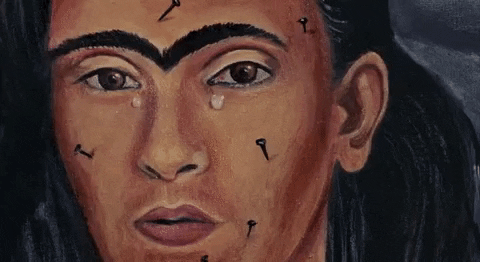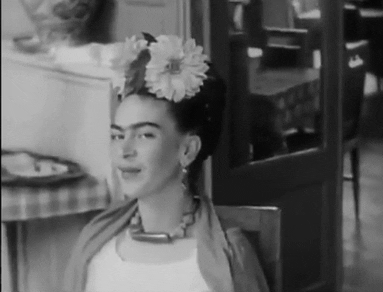Frida Kahlo in Managua
On February 8th the photo exhibit “Frida Kahlo through the lens of ten greats” was inaugurated in Managua, portraying different facets of the Mexican painter
By Yamlek Mojica L. (Confidencial)

HAVANA TIMES – We associate Frida Kahlo with those thick eyebrows, the flowers in her hair, and the colorful Mexican attire. According to the experts, all this was part of “a great performance” that also became her artistic image.
The “Ortiz Gurdian” Foundation is presenting through May in Managua the exhibit “Frida Kahlo through the lens of ten greats”, a series of photographs of Frida taken by ten important artists of the era, all of whom illustrate a more hidden side of the painter.
Juanita Bermudez, coordinator of the foundation’s cultural program, expressed in an interview for the television program “Esta Noche” [“Tonight”] that due to the impossibility of bringing pieces from Frida’s collection to the country, they sought to highlight her iconic image as art, since, according to the cultural emissary, “her life in itself was a great artistic performance.”
The fact is that Frida was marked by tragic events, and her work openly exposes this. At six, she contracted polio, a disease that paralyzes the muscles, and in her youth she suffered an accident that left her bedridden and subject to multiple operations.
 Although her paintings narrate her path under the shadow of these illnesses, they made it impossible for her to create a more extensive work than that we currently know. The paintings that exist are in the world’s largest museums or in private collections, making it impossible to present them in Nicaragua.
Although her paintings narrate her path under the shadow of these illnesses, they made it impossible for her to create a more extensive work than that we currently know. The paintings that exist are in the world’s largest museums or in private collections, making it impossible to present them in Nicaragua.
Nevertheless, the role that this Mexican woman has played in modern culture make her indispensable within the study of the arts. As such, the photos and an appreciation of her is equally important, Bermudez feels.
Although Frida was part German and a member of the middle class, she always embraced her Mexican roots and was proud of her indigenous ancestry. She demonstrated this in her clothing, a declaration to the empowerment of her native land.
“Her life was a performance”
Despite the fact that many of the photos of Frida were widely produced and well thought out, it’s said that the image we see of the painter was nothing less than an artistic “performance” with her own body.
Nevertheless, the photographic display exposes the humanity behind the artist. “Frida had someone that arranged her hair the way we see it in the photos, she had someone who placed the flowers, arranging them according to her conditions. It wasn’t something done suddenly and without thinking,” Bermudez states.
 Tatiana Torres, director of the Ortiz Foundation’s Art Center, noted that the majority of the photographers represented in the exhibit had a close connection with the artist. Among them were Antonio Kahlo, son of Cristina Kahlo, Frida’s younger sister, and Luciene Bloch, an intimate friend of Diego Rivera’s and of the artist.
Tatiana Torres, director of the Ortiz Foundation’s Art Center, noted that the majority of the photographers represented in the exhibit had a close connection with the artist. Among them were Antonio Kahlo, son of Cristina Kahlo, Frida’s younger sister, and Luciene Bloch, an intimate friend of Diego Rivera’s and of the artist.
“They all had some level of closeness, of intimacy, with her, which makes this selection of portraits even more special. All these photographers were characterized by knowing deeply the person they were immortalizing,” Torres affirms.
In the exhibition, there is more context given to each one of the photos and their creators. There are also reproductions of the painter’s works that will aid in understanding the shots. The gallery is located in the Art Center of the Ortiz Gurdian Foundation, on the first floor of the Malaga building in Plaza Espana. The exhibit will be open until May.

Frida Kahlo – neue Ausstellung „Ich male keine Träume” in Baden-Baden
Als Andre Breton 1938 Frida Kahlo und Diego Rivera in Mexiko besuchte und Fridas Gemälde “Was mir das Wasser gab“ sah, rief er aus: “Madame Rivera, Sie sind eine Surrealistin!
Frida Kahlo antwortete: “Ich bin Surrealist und weiß es nicht”. Später schrieb sie, in Anlehnung an das Surrealismus-Sein:
“Ich male keine Träume, ich male meine eigene Realität”.
Die neue Frida Kahlo-Ausstellung, die vom Kunstmuseum Gehrke-Remund in Baden-Baden organisiert und kuratiert wird; ist nach dreijähriger US-Tournee ab 3. Februar 2018 in Baden-Baden zu sehen.
Die Ausstellung liefert genau das, was der Titel sagt, indem sie Frida Kahlos Wirklichkeit nachbildet. Nicht ihre Träume, sondern ihre Welt, wie sie diese wahrgenommen hat, und wie sie wollte, dass die Betrachter diese sehen.
Basierend auf über 35 Jahren Frida Kahlo Studien zeigen Dr. Remund und Herr Gehrke nun Frida Kahlo Gemälde, die es in Europa zuvor noch nie zu sehen gab; dazu Vintage-Fotos, historische Videos und großformatige Fotos von Frida Kahlo.
Die Ausstellungsfläche des Museums wurde erweitert, um die mehr als 100 Replika-Gemälde und insgesamt über 400 Exponate zu beherbergen.
Eine mexikanische Umgebung wurde mit der Museumssammlung mexikanischer Retablos und Alebrijes (fantastische Tiere), die in den 30er Jahren in Mexiko geschaffen wurden, wiederhergestellt.
Die Ausstellung kann mit Hilfe eines Katalogs (kostenfrei, leihweise für jeden Besucher) in 4 Sprachen verfolgt werden, der die Hintergründe und Geheimnisse jedes Gemäldes enthüllt und es den Besuchern ermöglicht, Teil von Frida Kahlos Gemüts- und Weltzustand zu sein.
Das Kunstmuseum ist die einzige Institution der Welt, die von Mexiko die Genehmigung erhalten hat, alle Gemälde von Frida Kahlo zu replizieren. Der einzige Unterschied zu den Originalen ist das Etikett auf der Rückseite jedes Gemäldes: “Lizenzierte Replik von ©Banco de México Diego Rivera & Frida Kahlo Museums Trust / VG Bild-Kunst, Bonn 2008”.
Die Ausstellung dauert vom 3. Februar bis zum 1. Mai 2018.
Kunstmuseum Gehrke-Remund
Guterbahnhofstr. 9
76532 Baden-Baden
Deutschland
Dienstag bis Sonntag, 11:00- 17:00 Uhr
Tel-Nr.: 0049 152 55633001
http://www.Kunstmuseum-Gehrke-Remund.org
Über
Das Kunstmuseum Gehrke-Remund ist ein privates monographisches Kunstmuseum, das 2008 gegründet wurde. Ziel des Kunstmuseums Gehrke-Remund ist es, den Besuchern einen vollständigen Überblick über das Gesamtwerk der Frida Kahlo zu bieten und so die Entwicklung der Künstlerin von den frühen Werken bis zur Reife zu verfolgen. Bei den im Museum gezeigten Gemälden handelt es sich um handgemalte lizenzierte Repliken von ©Banco de México Diego Rivera & Frida Kahlo Museums Trust / VG Bild-Kunst, Bonn 2008. Das Kunstmuseum ist das einzige Museum der Welt, das die Erlaubnis erhalten hat, alle Frida-Kahlo-Gemälde von den Inhabern der Urheberrechte an den Werken des Künstlers zu replizieren.
Die Gründer des Kunstmuseums sind Hans-Jürgen Gehrke und Prof. Dr. Mariella C. Remund. Beide sind Mäzene, Sammler und leidenschaftliche Kunsthistoriker. Sie waren über 25 Jahre in leitenden Positionen in multinationalen Konzernen und akademischen Organisationen in Deutschland, Italien, Frankreich, der Schweiz, den USA, Spanien, Mexiko, Südamerika und China tätig.
Kunstmuseum Gehrke-Remund,
Güterbahnhofstr. 9
76532 Baden-Baden
Deutschland
Dienstag bis Sonntag, 11:00- 17:00 Uhr
Geschlossen am 24., 25. und 31. Dezember
Tel-Nr.: 0049 152 55633001
I’m glad Salma Hayek was able to play her in the most famous biopic. I heard that Madonna wanted that role, but the director refused. (What a disaster that would have been!) There has grown up a whole iconographic industry around Frida. Even in my little Vermont town some years back, around the time the film came out, there was a window display of Frida with reconstituted flying “Barbie dolls” modified to look like Frida! What a hoot! Too bad I didn’t take a foto of that outrageous–but very creative–display, which both Frida and Diego would have loved. Not only do I have the DVD of that bio, but also an earlier film where (the character of Frida) plays a significant role (the one starring Richard Burton about the assassination of Trotsky by “Frank Jacson,” who later plays such a significant role in Leonardo Padura’s “The Man Who Loved Dogs.” Incidentally, I am unique in having a tattoo (drawn when I was 18 and in the U.S. Navy) with words contained in Diego Rivera’s mural “Dream of the Almeida Central on a Sunday Afternoon.”
I have seen two films on Frida Kahlo, one I think was Cuban. Both were prior to the Salma Hayek film
In one of these films I recall the dramatic scene of her as a teenager, in her wheel chair, in the company of teenage boys. The boys are dressed very properly. They look like upper middle class boys on their way home from church.
When they reach a raised plaza somewhere in Mexico City, leaflets are brought out from under her blanket and scattered to the plaza below.